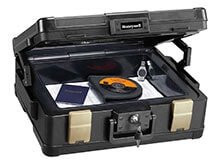 Honeywell manufacturers continue to produce high-class electronic safes to help protect your valuables from unauthorized persons. Honeywell electronic safes provide quality protection for valuable items, documents and other property from theft, fire, and other environmental hazards.
Honeywell manufacturers continue to produce high-class electronic safes to help protect your valuables from unauthorized persons. Honeywell electronic safes provide quality protection for valuable items, documents and other property from theft, fire, and other environmental hazards.
Honeywell safes use an electronic lock. It requires a preset digital combination to be inputted for the safe to open. However, entering the key to open the safe is a process that needs attention.
The following is the procedure for opening a Honeywell electronic safe:
- The first step involves inputting the correct code on the provided keypad on the safe. Ensure you enter the code in the correct sequence. Press the ‘#’ button once the full code has been entered. If the correct code is entered, the indicator light will turn green.
- Turn the handle in the clockwise direction and pull the door to open the safe.
- The safe provides for a five-second window after inputting the correct key and opening the safe door. If the time elapses before the door is opened, it will shut automatically requiring the key again for it to be opened.
- When locking the safe, push the door of the safe inside, then turn the handle anti-clockwise.
The following is the process of unlocking a newly bought Honeywell safe and inputting your first passcode:
- On the keypad, enter the factory passcode ‘159’ and press the ‘#’ key.
- Turn the circular door handle clockwise and pull the door of the safe to open it.
- To set your own passcode, enter the code ‘159’ again on the keypad. Inside the safe, there is a small red button on the right of the safe door. Push the button firmly before releasing it
- After releasing the red button, the device will beep three times. An amber LED light turns on.
- Now you are ready to input your passcode. Choose your desired code between ‘3’ and ‘9’ which will be your new combination code. Finally, press the # button to confirm the code.
 Situations occur where the owner of the safe loses the combination code in one way or another. Without the combination code, one cannot access the safe. Luckily, Honeywell safes manufacturers provide an override key.
Situations occur where the owner of the safe loses the combination code in one way or another. Without the combination code, one cannot access the safe. Luckily, Honeywell safes manufacturers provide an override key.
The override key is used to access the safe to change the old password and input a new one. Accessing the safe using the override key is also not a direct process and has a specific procedure.
The following is the procedure of using the override key to open the safe and change the password:
- There are two types of override keys: the first key is the Entry Key which is entered into the key slot and turned in the clockwise direction. The second key is called the emergency override key which when put into the key slot, is turned anti-clockwise.
- Both keys will open the safe door when turned in their respective directions.
- After turning the key, pull the safe door to open it. If the door is not opened within 5 seconds, it automatically locks itself, and one has to repeat the process.
- To change the password, take off the battery compartment. Then reinstall the battery compartment.
- With the door of the safe open, turn the knob anti-clockwise to re-lock the door bolts.
- Next, remove the override key and input the passcode ‘159B’. Immediately turn the knob clockwise to unlock the door bolts within 5 seconds.
- Still, with the door open, press the ‘C’ button. A yellow light will come on. The light is a signal for you to start inputting the new passcode. Choose a passcode from ‘3’ to ‘9’ with the letter ‘B’ at the end. The process of inputting the passcode should not last for more than 30 seconds.
- Finally, the safe will produce a beep, and the yellow light will go off.
